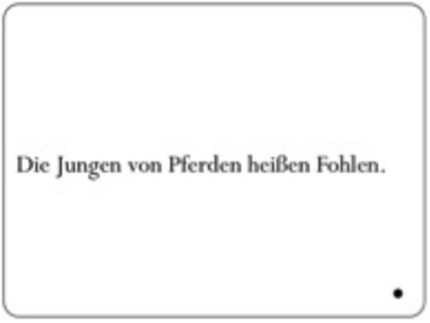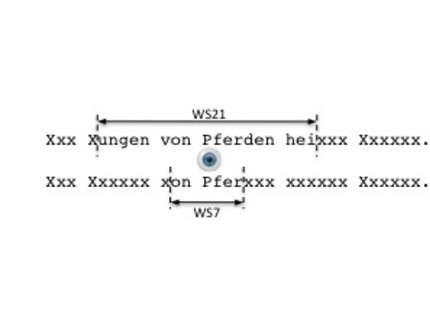Study concerning the development of the reading ability of primary-schoolers
Test procedure
First-grade level sentences and age appropriate sentences are presented to and read silently by the children. In irregular distances two pictures are presented and the child has to choose the one that matches the sentence read before. This control is put into place in order to preserve concentration whilst reading.
During the reading process the eye movements are tracked by the Eyelink 1000 system. These recordings make it possible to accurately retrace the children’s eye movements and to understand how they change during the further process of the reading development.
Reading Experiment MW (Moving-Window-Technique)
Because we know to the exact millisecond which part of the sentence the child is reading we can „manipulate the flow of reading“.
For this purpose a „window“ is constructed around the child’s fixation point. This means that on the left and right side of the fixation point there are, for example, only 10 letters visible (left figure above). In other sentences only 3 letters to the left and right are visible (left figure beneath).
Results
The fewer letters are available, the slower is the reading flow. While first-graders are not effected by the window-size (because they read letter by letter), a small window strongly limits the reading rate of two- and third-graders.
The window-size which enables a child to read in his or her „normal“ reading rate corresponds to their perceptual span, meaning the amount of information that can be processed during one glance. For adults these are usually 14-15 letters on the right side.
It is interesting to learn that the reading abilities of the children start to vary more and more with increasing age. The PhD candidate Anja Sperlich, who was scientifically co-responsible for the first and second time of testing, attributes these findings to the fact that „the contact with books in preschools […] [encourages] the interest in reading, which apparently influences the frequency of reading, which affects the reading ability.“
The data analysis includes the reading rate, the length of forward saccades, the probability of refixations, the duration of the first fixation, the duration of glances and the total reading time. The reading rate (number of read words per minute) shows that the reading accelerates in the course of development. This graphic depicts the number of read words per minute as a function of the window-size, so the number of visible letters. One can observe that at an average third-graders read more words per minute than first-graders. In addition to that the third-graders’ advantage of preprocessing is clearly noticeable. The bigger the window-size, the faster is the reading, at least until at a certain window-size higher numbers of visible letters do not make a difference in the reading rate anymore.
Johannes Meixner & Anja Sperlich
How efficient is first-grader’s word decoding compared to third grader’s decoding skill? What are causes that some children become high proficient readers and some don’t? Is it the specific academic environment or inter-individual differences in working memory, reading amount or motivation? How is reading comprehension on word, sentence and text level linked to reading fluency?
Reading is a central cultural cognitive ability that children acquire during elementary school. As members of the DFG-founded longitudinal PIER study, Anja Sperlich and Johannes Meixner under supervision of Dr. Laubrock track German abecedarians reading development from first to sixth grade and beyond. With the help of the Eyelab they precisely measure the children’s eye movements during natural reading, inferring how long it takes to decode words of varying difficulty, which parts of a sentence need to be re-read and which parts are skipped. The focal point of investigation is the perceptual span, i.e. how much linguistic information can be processed during one fixation. The longitudinal design of the study and the comprehensive PIER data set on motivation, emotion, memory and cognitive competencies, enable them to identify risk- and protective factors that influence reading development. They already found that lexical decoding is an influential precursor of perceptual-span development during the first three grades. If you are further interested we highly recommend reading Sperlich, Schad & Laubrock, 2015. The journal article offers an overview of the perceptual span development during the first three grades of elementary school.




